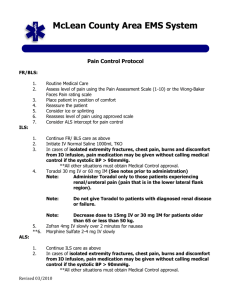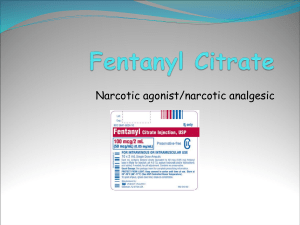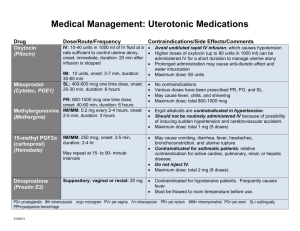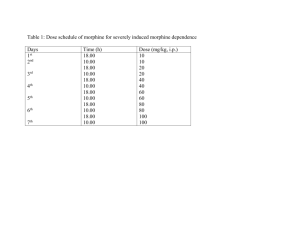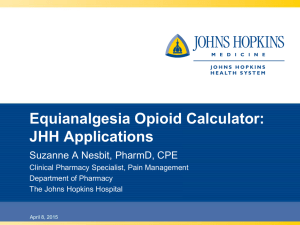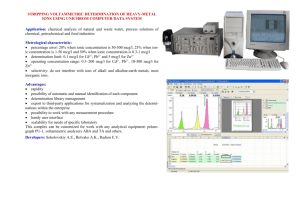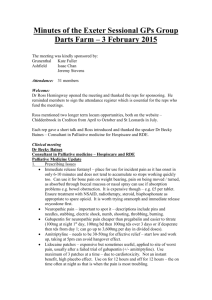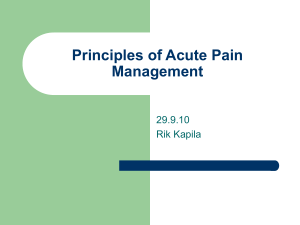SPECIALIST PALLIATIVE CARE ADVICE Trinity Hospice Advice
advertisement
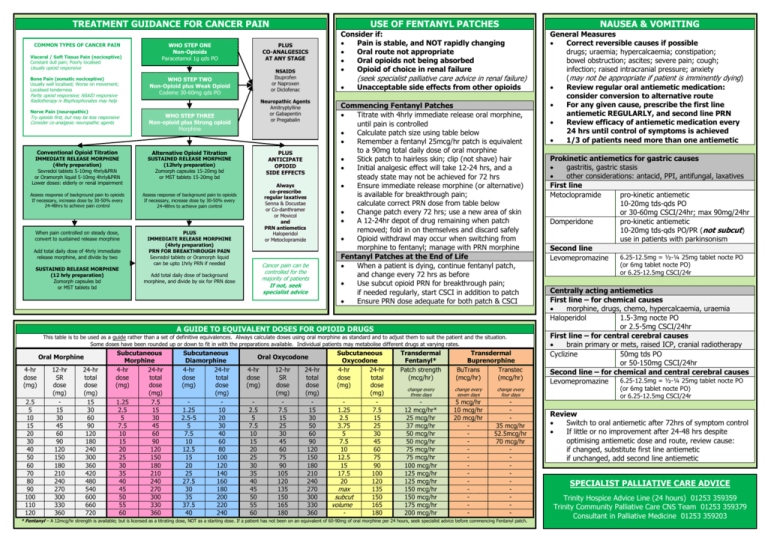
TREATMENT GUIDANCE FOR CANCER PAIN COMMON TYPES OF CANCER PAIN Visceral / Soft Tissue Pain (nociceptive) Constant dull pain; Poorly localised WHO STEP ONE Non-Opioids Paracetamol 1g qds PO PLUS CO-ANALGESICS AT ANY STAGE Usually opioid responsive Bone Pain (somatic nociceptive) Usually well localised; Worse on movement; Localised tenderness Partly opioid responsive; NSAID responsive Radiotherapy iv Bisphosphonates may help Nerve Pain (neuropathic) Try opioids first, but may be less responsive Consider co-analgesic neuropathic agents Conventional Opioid Titration Alternative Opioid Titration Assess response of background pain to opioids If necessary, increase dose by 30-50% every 24-48hrs to achieve pain control Assess response of background pain to opioids If necessary, increase dose by 30-50% every 24-48hrs to achieve pain control When pain controlled on steady dose, convert to sustained release morphine PLUS IMMEDIATE RELEASE MORPHINE (4hrly preparation) PRN FOR BREAKTHROUGH PAIN Sevredol tablets or Oramorph liquid can be upto 1hrly PRN if needed SUSTAINED RELEASE MORPHINE (12 hrly preparation) Zomorph capsules bd or MST tablets bd Neuropathic Agents Amitryptylline or Gabapentin or Pregabalin WHO STEP THREE Non-opioid plus Strong opioid Morphine SUSTAINED RELEASE MORPHINE (12hrly preparation) Zomorph capsules 15-20mg bd or MST tablets 15-20mg bd Add total daily dose of 4hrly immediate release morphine, and divide by two NSAIDS Ibuprofen or Naproxen or Diclofenac WHO STEP TWO Non-Opioid plus Weak Opioid Codeine 30-60mg qds PO IMMEDIATE RELEASE MORPHINE (4hrly preparation) Sevredol tablets 5-10mg 4hrly&PRN or Oramorph liquid 5-10mg 4hrly&PRN Lower doses: elderly or renal impairment USE OF FENTANYL PATCHES PLUS ANTICIPATE OPIOID SIDE EFFECTS Always co-prescribe regular laxatives Senna & Docustae or Co-danthramer or Movicol and PRN antiemetics Haloperidol or Metoclopramide Cancer pain can be controlled for the majority of patients If not, seek specialist advice Add total daily dose of background morphine, and divide by six for PRN dose Consider if: Pain is stable, and NOT rapidly changing Oral route not appropriate Oral opioids not being absorbed Opioid of choice in renal failure (seek specialist palliative care advice in renal failure) Unacceptable side effects from other opioids Commencing Fentanyl Patches Titrate with 4hrly immediate release oral morphine, until pain is controlled Calculate patch size using table below Remember a fentanyl 25mcg/hr patch is equivalent to a 90mg total daily dose of oral morphine Stick patch to hairless skin; clip (not shave) hair Initial analgesic effect will take 12-24 hrs, and a steady state may not be achieved for 72 hrs Ensure immediate release morphine (or alternative) is available for breakthrough pain; calculate correct PRN dose from table below Change patch every 72 hrs; use a new area of skin A 12-24hr depot of drug remaining when patch removed; fold in on themselves and discard safely Opioid withdrawl may occur when switching from morphine to fentanyl; manage with PRN morphine Fentanyl Patches at the End of Life When a patient is dying, continue fentanyl patch, and change every 72 hrs as before Use subcut opioid PRN for breakthrough pain; if needed regularly, start CSCI in addition to patch Ensure PRN dose adequate for both patch & CSCI A GUIDE TO EQUIVALENT DOSES FOR OPIOID DRUGS This table is to be used as a guide rather than a set of definitive equivalences. Always calculate doses using oral morphine as standard and to adjust them to suit the patient and the situation. Some doses have been rounded up or down to fit in with the preparations available. Individual patients may metabolise different drugs at varying rates. Oral Morphine 4-hr dose (mg) 2.5 5 10 15 20 30 40 50 60 70 80 90 100 110 120 12-hr SR dose (mg) 15 30 45 60 90 120 150 180 210 240 270 300 330 360 24-hr total dose (mg) 15 30 60 90 120 180 240 300 360 420 480 540 600 660 720 Subcutaneous Morphine 4-hr 24-hr dose total (mg) dose (mg) 1.25 7.5 2.5 15 5 30 7.5 45 10 60 15 90 20 120 25 150 30 180 35 210 40 240 45 270 50 300 55 330 60 360 Subcutaneous Diamorphine 4-hr 24-hr dose total (mg) dose (mg) 1.25 10 2.5-5 20 5 30 7.5 40 10 60 12.5 80 15 100 20 120 25 140 27.5 160 30 180 35 200 37.5 220 40 240 Oral Oxycodone 4-hr dose (mg) 2.5 5 7.5 10 15 20 25 30 35 40 45 50 55 60 12-hr SR dose (mg) 7.5 15 25 30 45 60 75 90 105 120 135 150 165 180 24-hr total dose (mg) 15 30 50 60 90 120 150 180 210 240 270 300 330 360 Subcutaneous Oxycodone 4-hr 24-hr dose total (mg) dose (mg) 1.25 7.5 2.5 15 3.75 25 5 30 7.5 45 10 60 12.5 75 15 90 17.5 100 20 120 max 135 subcut 150 volume 165 180 Transdermal Fentanyl* Patch strength (mcg/hr) Transdermal Buprenorphine BuTrans Transtec (mcg/hr) (mcg/hr) change every three days change every seven days change every four days 12 mcg/hr* 25 mcg/hr 37 mcg/hr 50 mcg/hr 50 mcg/hr 75 mcg/hr 75 mcg/hr 100 mcg/hr 125 mcg/hr 125 mcg/hr 150 mcg/hr 150 mcg/hr 175 mcg/hr 200 mcg/hr 5 mcg/hr 10 mcg/hr 20 mcg/hr - 35 mcg/hr 52.5mcg/hr 70 mcg/hr - * Fentanyl – A 12mcg/hr strength is available; but is licensed as a titrating dose, NOT as a starting dose. If a patient has not been on an equivalent of 60-90mg of oral morphine per 24 hours, seek specialist advice before commencing Fentanyl patch. NAUSEA & VOMITING General Measures Correct reversible causes if possible drugs; uraemia; hypercalcaemia; constipation; bowel obstruction; ascites; severe pain; cough; infection; raised intracranial pressure; anxiety (may not be appropriate if patient is imminently dying) Review regular oral antiemetic medication: consider conversion to alternative route For any given cause, prescribe the first line antiemetic REGULARLY, and second line PRN Review efficacy of antiemetic medication every 24 hrs until control of symptoms is achieved 1/3 of patients need more than one antiemetic Prokinetic antiemetics for gastric causes gastritis, gastric stasis other considerations: antacid, PPI, antifungal, laxatives First line Metoclopramide pro-kinetic antiemetic 10-20mg tds-qds PO or 30-60mg CSCI/24hr; max 90mg/24hr Domperidone pro-kinetic antiemetic 10-20mg tds-qds PO/PR (not subcut) use in patients with parkinsonism Second line 6.25-12.5mg = ½-¼ 25mg tablet nocte PO Levomepromazine (or 6mg tablet nocte PO) or 6.25-12.5mg CSCI/24r Centrally acting antiemetics First line – for chemical causes morphine, drugs, chemo, hypercalcaemia, uraemia Haloperidol 1.5-3mg nocte PO or 2.5-5mg CSCI/24hr First line – for central cerebral causes brain primary or mets, raised ICP, cranial radiotherapy Cyclizine 50mg tds PO or 50-150mg CSCI/24hr Second line – for chemical and central cerebral causes 6.25-12.5mg = ½-¼ 25mg tablet nocte PO Levomepromazine (or 6mg tablet nocte PO) or 6.25-12.5mg CSCI/24r Review Switch to oral antiemetic after 72hrs of symptom control If little or no improvement after 24-48 hrs despite optimising antiemetic dose and route, review cause: if changed, substitute first line antiemetic if unchanged, add second line antiemetic SPECIALIST PALLIATIVE CARE ADVICE Trinity Hospice Advice Line (24 hours) 01253 359359 Trinity Community Palliative Care CNS Team 01253 359379 Consultant in Palliative Medicine 01253 359203
